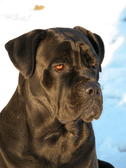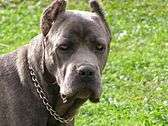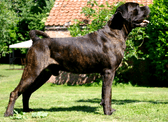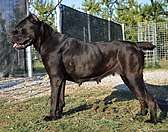Cane Corso
The Cane Corso (pronounced [ˈkaːne ˈkɔrso]) is a large dog breed of Southern Italian origins that is used for personal protection, tracking, law enforcement, and as a guard dog.[2]
| Cane Corso | |||||||||||||||||
|---|---|---|---|---|---|---|---|---|---|---|---|---|---|---|---|---|---|
.jpg) | |||||||||||||||||
| Other names |
| ||||||||||||||||
| Origin | Italy | ||||||||||||||||
| |||||||||||||||||
| |||||||||||||||||
| Dog (domestic dog) | |||||||||||||||||
Description
.jpg)
The Cane Corso is a large Italian Molosser, which is closely related to the Neapolitan Mastiff. In name and form the Cane Corso predates its cousin the Neapolitan Mastiff. It is well muscled[3] and less bulky than most other Mastiff breeds. The breed is known as a true and quite possibly the last of the coursing Mastiffs. The Cane Corso is typically used as fighting or guard dog (most common) but are great with family and children. The official Fédération Cynologique Internationale (FCI) standard expects ideal dogs to stand 58–70 cm (23–28 in) at the withers, with females in the lower range (58–66 cm (23–26 in)) and males in the higher (62–70 cm (24–28 in)). Weight should be in keeping with the size and stature of these dogs, ranging from 45–50 kilograms (99–110 lb) for males and from 40–45 kilograms (88–99 lb) for females.[1]
The head of the Cane Corso is arguably its most important feature. It is large and imposing. The forehead should be flat and convergent to the muzzle. The muzzle is flat, rectangular (when viewed from above), and generally as wide as it is long; approximately 33% the total length of the skull (a ratio of 2:1). The eyes are almond in shape, set straight and when viewed from the front, set slightly above the line of the muzzle. Darker eyes are preferred, however, the color of the eyes tends to emulate the shade of brindling in the coat.[4]
Cane Corso appear in two basic coat colours: black and fawn. This is further modified by genetic pigment dilution to create "blue" (grey, from black) and frumentino or formentino (from fawn, where the mask is blue/grey) colours. Brindling of varying intensity is common on both basic coat colours as well, creating Tigrato (black brindle), and Grigio Tigrato (blue brindle). White markings are common on the chest, tips of toes, the chin, and the bridge of the nose.
A 2017 study of 232 Cane Corso dogs across 25 countries found an average life span of 9.3 years, varying with different coat colours. The longest living were black brindle dogs (10.3 years) followed by brindle dogs (10.1 years), grey brindle dogs (9.8 years), fawn dogs (9.0 years), black dogs (9.0 years), grey dogs (9.0 years) and other colour dogs (8.1 years).[5]
These dogs are docile and affectionate to their owners, loving with children and family, and easily trained. They are an unequalled protector of the owners and their property.[6] They can also be very aggressive toward strangers and difficult to handle from a veterinary standpoint.
The average litter size of Cane Corso is four to six puppies.[7]
History
_Geschiedenis_van_het_Romeinse_Rijk_(serietitel)_Frontespizio_della_Isto%2C_RP-P-1929-168.jpg)
The Cane Corso is considered to be a descendant of the old Roman war dog the Canis Pugnax or the Molossian.[1] Its name derives from cane da corso, an old term for those catch dogs used in rural activities for cattle and swine, as distinct from cane da camera which indicates the catch dog kept as a bodyguard. In the recent past, its distribution was limited to some regions of Southern Italy, especially in Basilicata, Campania, and Apulia.[4]
Large similar catch dogs have been present in Italy for centuries observed mainly in artistic representations as those from Bartolomeo Pinelli. At the beginning of the 20th century this type of dog or landrace was not as well known in their country as before and was presented at a dog show for the first time in 1914 in Milan surprising the show's judge Fabio Caielli. Caielli and the dog's owner Mario Monti traveled around Italy looking for dogs of the same type to form a breed.[8][9]
Piero Scanziani was a writer fascinated by dogs and found this blue brindle Italian dog in a dog show in the 1940s. It was a type of dog that he believed to be the legendary extinct Molossus quoted by Columella and other writers. They were the type of dog recovered by Caielli and Monti but they were not yet numerous. Scanziani started to bred the breed and calling it Molosso or Molosso Italiano. Guaglione was the first dog acquired by Scanziani and was the patriarch of the Molosso. Scanziani wrote about the Molosso publicizing the breed and enabling its formalization and recognition by the Italian Kennel Club in the same decade. The first breed standard cited the names Cane Corso, and mastino and cane da presa as synonyms to the Molosso. In subsequent years the new breed adopted only the Mastino Napoletano name and acquired different physical traits through the decades that separated it from its old synonyms.
However, dogs of the old standard continued to exist in a parallel and discreet manner and known by many names including Cane Corso and Dogo de Puglia.
As life changed in the southern Italian rural farms in the 20th century, the Corso began to become rare. A group of enthusiasts as Paolo Breber began recovery activities designed to bring the dog back from near extinction in the late 1970s. By 1994, the breed was fully accepted by the Italian Kennel Club (ENCI) as the 14th Italian breed of dog. The FCI provisionally accepted the Corso in 1997, and ten years later was fully recognised internationally. In the US, the American Kennel Club first recognized the Cane Corso in 2010.[3] The popularity of the breed continues to grow, ranking in 40th place in the United States in 2016, a jump from 50th place in 2013 and 60th in 2012.[10] Today the breed is used as a guardian, protection, tracking and police dog.[2]
Gallery
 Cane Corso with uncropped ears.
Cane Corso with uncropped ears. Cane Corso, blue coat, cropped ears
Cane Corso, blue coat, cropped ears Cane Corso with ears and tail, brown/brindle coat
Cane Corso with ears and tail, brown/brindle coat- Formentino Cane Corso puppy


References
- "FCI Standard 343" (PDF). FCI. Retrieved 17 October 2014.
- "Breed Standards : Cane Corso Italiano - United Kennel Club (UKC)". www.ukcdogs.com. Retrieved 4 February 2019.
- "Get to Know the Cane Corso", 'The American Kennel Club', Retrieved 20 May 2014
- Cane Corso Standard Archived 2009-01-11 at the Wayback Machine of Ente Nazionale della Cinofilia Italiana (ENCI)
- Korec, Evžen (2017), "Longevity of Cane Corso Italiano dog breed and its relationship with hair colour" (PDF), Open Veterinary Journal, 7 (2): 170–173
- "AKC Official Standard of the Cane Corso" (PDF). Retrieved 4 February 2019.
- "Cane Corso Italiano Dog Breed Information and Pictures". www.dogbreedinfo.com. Retrieved 4 February 2019.
- "Cane Corso history" (in French). Temple des Brumes.
- Lavanche, Federico (2015-08-15). "Canis Pugnax, il cane Romano". Cane Corso Italiano - razza (in Italian). Retrieved 2020-05-24.
- "AKC Dog Registration Statistics", The American Kennel Club, accessed 20 May 2014
External links
| Wikimedia Commons has media related to Cane Corso. |
- Cane Corso at Curlie
- Cane Corso Association of America (CCAA), www.canecorso.org